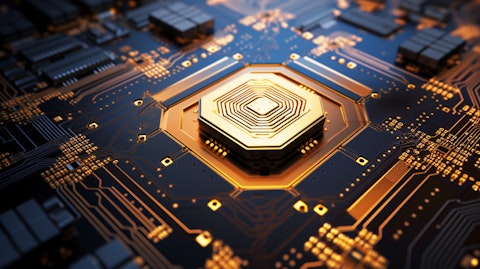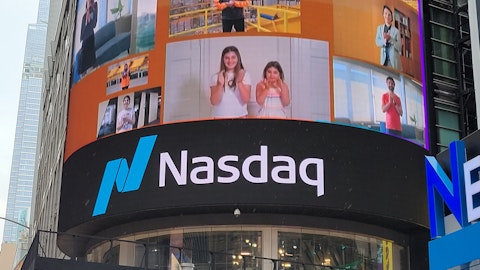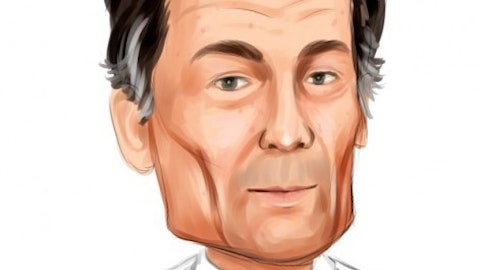Tower Semiconductor Ltd. (NASDAQ:TSEM) Q3 2023 Earnings Call Transcript November 13, 2023
Tower Semiconductor Ltd. beats earnings expectations. Reported EPS is $0.54, expectations were $0.51.
Operator: Ladies and gentlemen, thank you for standing by. Welcome to the Tower Semiconductor Third Quarter 2023 Financial Results conference call. All participants are currently in a listen-only mode. Following management’s prepared statements, instructions will be given for the question-and-answer session. [Operator Instructions] As a reminder, this conference is being recorded, November 13, 2023. Joining us today are Mr. Russell Ellwanger, Tower’s CEO; and Mr. Oren Shirazi, CFO. I would now like to turn the conference over to Ms. Noit Levy, Senior Vice President of Investor Relations and Corporate Communications. Ms. Levy, please go ahead.
Noit Levy: Thank you, and welcome to Tower Semiconductor’s financial results conference call for the third quarter of 2023. Before we begin, I would like to remind you that some statements made during this call may be forward-looking and are subject to uncertainties and risk factors that could cause actual results to be different from those currently expected. These uncertainties and risk factors are fully disclosed in our Form 20-F, F-4, F-3 and 6-K filed with the Securities and Exchange Commission, as well as filings with the Israeli Securities Authority, they also available on our website. Tower assumes no obligation to update any such forward-looking statements. Please note that the third quarter of 2023 financial results have been prepared in accordance with US GAAP.
The financial tables and data in today’s earnings release and in this earnings call also include certain adjusted financial information that may be considered non-GAAP financial measures under Regulation G and related reporting requirement as established with the Securities and Exchange Commission. The financial tables include full explanation of these measures and the reconciliation of these non-GAAP measures to the GAAP financial measures. In today’s call, we have a supporting slide deck that complements our conference call. This presentation is accessible on our company’s website and is also integrated into the webcast for your convenience. Now, I’d like to turn the call to our CEO, Mr. Russell Ellwanger. Russell, please go ahead.
Russell Ellwanger: Welcome, everyone, and thank you for joining our call today. Being the first financials release call we are holding since November 2021, we will include in today’s call a longer-term financial model stating the reasons for and the margins resulting from the new capacity agreements that we have announced in the past years. An important aspect of our growth strategy is manufacturing efficiency and scale. Increasing capacity in an accretive cost-efficient manner is a competitive edge. First, looking at this past quarter, our revenue for the third quarter was $358 million, down year-over-year, reflective of challenging market conditions. At this revenue level, Fab utilizations were Fab 1 6-inch, about 55%; Fab 2 8-inch, about 75%; Fab 3 8-inch, about 40%, due primarily to the weakness in data centers; Fab 5 8-inch, at about 60%; Fab 7 12-inch, about 60%; and Fab 9 8-inch, about 65%.
As you can see, with the present utilization levels, we have the ability to quickly ramp up manufacturing to capitalize on a market rebound. A positive point demonstrating our operational efficiency, at these lower utilization levels, excluding the accretive impact of one-time items, we had substantial operating profit. Currently, we are seeing a return in several areas to rational customer inventory levels and are beginning to experience some upsides relative to customer forecasts as end-market opportunities present themselves. We have yet to see customers increase their forecasts, although certainly in the RF segment, inventory levels have reached or fallen below the previous steady state. We remain proactive with our customers, providing operational flexibility, as even small changes to end markets, if one has the ability to act quickly, could have a disproportionately positive impact on near-term results.
For the fourth quarter of 2023, we expect revenue of $350 million, plus or minus 5%. We are active and committed to creating sustainable value for all of our stakeholders. As we stated at our last investor call on September 5th, Tower is actively embedding excellence in everything we do which we define as effective, efficient, and at the highest quality. Tower is extremely efficient, as measured by the 10-point drop from gross margins to operating margins, reflecting total OpEx of about 10% of revenue. Effectives can be measured by gross margins, which mean value-added offerings at manufacturing scale. Our offerings are value-add. A bit later, our CFO, Mr. Oren Shirazi, will discuss the long-term financial model, showing the result of increasing our manufacturing scale, reflecting Tower’s present capacity footprint and the additional capacity capabilities resulting from our investments in the Agrate facility and in the New Mexico facility with ST and with Intel, respectively.
These technologies that create value, almost by definition, are those which serve exciting high-growth markets. Within the analog world that we serve, we are focused on three megatrends, seamless connectivity, served by our RF roadmaps; green everything, served by our power platforms; and smart systems, served by our sensors and display offerings. We are committed to continue to advance the platform serving these trends, which in turn empowers us to meet the demands of our customers and remain at the forefront of industry trends. Our RF Mobile business is primarily composed of handset RF components, such as switches, antenna tuners, and low-noise amplifiers, built on our RF-SOI technology. As you know, the handset market has been weak in 2023, although there are signs of potential recovery, as evidenced by potential quarterly revenue gains through all of 2023, from a bottom in Q1 ’22.
Longer term, we anticipate a market recovery, along with increased adoption of 5G in developing nations, to contribute to further growth. To accelerate internal growth that outpaces the market, we have invested in advanced RF-SOI technology with the recent release of design kits for [QT10], our 10th generation process, offering the industry’s best Ron Coff figure of merit, striving improved reception and battery life in handset. This technology is prototyping today in 200 mm and we are releasing design kits in a 300 mm version this quarter. We have significant prototyping and design activity and anticipate this new technology to contribute meaningfully to revenue, with design wins already with two of the top five front-end module providers and active engagements with multiple others.
Our RF infrastructure business is primarily composed of Silicon Germanium and Silicon Photonics for optical transceivers and data centers, artificial intelligence clusters, and telecom networks. Over the past three months, we have met with most all of our major customers throughout the world. One thing that was striking is that the near-term move to 800G data centers appear to be much more aggressive than is depicted in analyst reports, resulting in a stronger cycle ramp for the industry as Silicon Photonics plays an increased role at 800G and beyond. For your reference, please see Slide 6. Tied to this, we are seeing increased orders for Silicon Photonics, with customers forecasting a substantial ramp continuing through 2024 and beyond. Currently, we have over 50 active SiPho customers serving datacenter telecom, automotive LiDAR, and optical computing.
In the third quarter, we announced a multi-generation partnership with InnoLight, the worldwide leader in datacenter optical solutions. This partnership highlights the strength of our offerings, with the end customers representing the core of all hyperscalers, enabling cutting-edge technology to support the growing demands of data centers including AI and next-generation telecom networks. For our Silicon Germanium business, we are seeing significant first-year design wins for linear pluggable optics, LPO components, which promise to replace costly DSPs in advanced optical modules. For your reference, please see Slide 7. LPOs integrate some additional functionality into traditional Silicon Germanium drivers and trans-impedance amplifiers to eliminate the need for costly and power-hungry deep digital, digital signal processors in many 400G and 800G applications.
This new innovative technology offers improved cost, reduced power consumption, and reduced latency for data center, including for AI applications. We have also seen design wins and first orders for retimers used in active copper cables built with our Silicon Germanium technology, serving top data center hyperscalers and hyperscaler providers. It is an alternative to more costly pluggable optics, particularly for short-reach applications, further expanding our Silicon Germanium total available market. Finally, and also of significant importance, we see increased activity towards the newer market of satellite internet service using silicon germanium phased array, offering the best performance and cost tradeoff in terrestrial receivers employed by these systems.
For your reference, please see Slide 8. This application space promises to meaningfully increase the Silicon Germanium’s total available market over the next several years, as each receiver requires, on average, 250 silicon germanium phased array ICs, with a major win having been awarded to us this past quarter. Turning to our Power IC business, in the past few months, we had two very major wins. Firstly, from a premier power management integrated device maker for the next generation 65-nanometer BCD, and secondly, from a leading analog fabless company with a design win with their first tier end customer. These activities are forecast and aligned with at least one end customer to grow to several tens of thousands of wafers per month, and is a major catalyst for entering the New Mexico fab manufacturing agreement.

In the imaging market, we continue our focus on creating highly differentiated technologies for industrial, medical, and automotive use, scoring a major win in Q3, where we partner to provide sensor technology to an iconic mirrorless camera company. For your reference, please see Slides 10 and 11, which define this market. In the Industrial segment, we gained an entire next generation line with a leading imaging provider. The display market is undergoing a revolution with the rapid growth of the VR and AR markets. Technology-wise, in order to meet these markets’ revolution and brightness requirements, a shift from the traditional LCD-based displays to organic LED on silicon is required. For your reference, please see Slide 12. We have developed a 5V platform and are currently at advanced stages of creating a 10V platform for even higher brightness, and are engaged with leading display suppliers in Korea and China.
This is the next big thing in the display area, and we are technologically well positioned to take a substantial market share at this exciting new market. Providing a revenue breakdown for the third quarter of 2023, Sensors and Displays represented 18%, RF Mobile business represented 26%, RF Infrastructure represented 10%, Power IC business 21%, Discrete business 17%, Mixed-Signal CMOS about 6%, with about 2% Miscellaneous for this period. Automotive, which has served through several of the above-mentioned technologies, was at about 17%. I’m pleased to announce two strategic organizational changes we just implemented. These changes have been carefully designed to enable our next series of steps to achieve the next peak in our progress. Dr. Marco Racanelli was promoted to serve as Tower’s President.
As such, he is responsible for all business unit and sales activities and organizations. Dr. Avi Strum was promoted to be Tower’s Chief Technology Officer, responsible among others, for a four-to-six-year accretive technology roadmap with associated activities and all M&A activities. I believe that these organizational changes will enhance Tower’s value proposition and continuous profitable growth. Please join me in wishing Marco and Avi much success, Godspeed. Oren, please.
Oren Shirazi: Thank you, Russell. We released today our quarterly results reporting revenues of $358 million, gross profit of $87 million, and net profit of $342 million, which net profit included $290 million of net profit impact associated with the merger contract termination fee received from Intel. I will start my review by analyzing the P&L highlights, followed by our balance sheet and a presentation of our long-term financial model. Revenue for the quarter ended in September 2023 with $358 million compared to $357 million in the prior quarter, and gross profit for the quarter ended in September 2023 with $87 million, similar to the growth profit in the prior quarter. Operating profit and net profit for the quarter included the net impact of merger contract termination fee we received from Intel in the amount of $314 million net of associated costs.
This amount is included in operating profit. The net profit impact after tax is $290 million based on a 7.5% preferred income tax rate that applies to us in Israel. Including the termination fees, operating profit for the quarter was $362 million as compared to $51 million in the prior quarter, and net profit was $342 million, or $3.10 basic earnings per share, compared to net profit of $51 million, or $0.46 per share of basic earnings in the prior quarter. Our balance sheet, as of the end of September, totaled $2.8 billion, primarily comprised of $1.1 billion of fixed assets, mostly machinery and equipment, and $1.7 billion of current assets, 72% of which were cash deposits and marketable securities. Current assets ratio, reflecting the multiple by which current assets are larger than short-term liabilities, is very strong by a multiple of 6.7x as compared to 4.8x in the prior quarter.
Shareholder’s equity increased by 17% quarter-over-quarter and by 24% as compared to its amount in the end of FY22, and reached a total of almost $2.4 billion. Our strong financial position enables us to plan the following investments in growth opportunities that are aligned with our vision. One, approximately $500 million of total aggregate cash was allocated to make investments in equipment and other CapEx items required for the 12-inch factory in Agrate, Italy, required for Tower portion of the STMicro partnerships, of which $100 million were already invested in FY22, and an additional $150 million were invested to-date. Two, as announced two months ago, we will invest $300 million to buy equipments and other CapEx items that we will own in Intel’s fab in New Mexico, enabling Tower to ramp up production and manufacturing for its customers.
Three, we expect our maintenance CapEx baseline level to remain, as previously announced, between $180 million and $200 million per annum. And four, we will continue to invest to refine our product mix in the technologies and markets that Russell previously described to enhance our flexibility, to cross-manufacture at our multiple factories. All should result in a richer mix from a margins point of view, and all in accordance with our growth strategy. Russell described previously the market, technologies, and customer demand which drives our need to increase our capacity. I will now outline our target financial model, which is based on the assumption that the presently expressed and forecasted customer’s demand for the products, technologies, and markets Russell described will result in 85% utilization of our capacity, including the ramp-up of Agrate and New Mexico.
I refer to the target financial model, a summary of which is presented in Slide 14 in this call’s slide deck. Based on this assumption, we believe we will have the opportunity to achieve annual revenue of about $2.65 billion. Achieving this level of revenue should, according to this model, result in an annual growth profit of $740 million, an annual operating profit of $560 million, and an annual net profit of $500 million. To provide context, reaching revenue growth at a level of 1.9 times of our last published quarter annualized revenue run rate would result in growth profit, operating profit, and net profit to be 2.1x, 2.9x, and 2.4x, respectively, as compared to the last published quarter annualized run rate, excluding the accretive one-time impacts as outlined in the model.
Our model demonstrates several key indicators of our efficiency and effectiveness as follows. One, we are showing an increase of 86% in revenue, while keeping OpEx costs below 10% of revenue. Our incremental growth operating and net margins as a percentage of the added revenue of $1.2 billion stated in the model should be 32%, 30%, and 24% respectively, which are higher than our current baseline margins. Three, by increasing our revenue by 86% from the last reported quarter run rate, we should increase our operating profit by 187% and our net profit by 140%. In summary, achieving this planned target would result in annual revenue of about $2.65 billion, annual gross profit of $740 million, $560 million in operating profit per annum, and $500 million in net profit per annum.
And now I’d like to turn the call back to our CEO, Mr. Russell Ellwanger.
Russell Ellwanger: Thank you, Oren. Truly very exciting. To close, I’ll speak to the situation in Israel. October 7th was an act of pure evil, a direct and purpose attack on civilians by Hamas using the tools of murder, rape, and mutilation, the same tools used by Putin in Ukraine that had been employed by other depraved despots throughout history. In this present instance, under Hamas leaders who lived a life of billionaires, harbored and shielded safely in foreign nations, carrying nothing for any God-given human values, no value for life at all, certainly not for Israelis, but also not for their own people who they use as pawns. Since this time, I’ve been extremely moved by the outpouring of warm thoughts and prayers for Tower and our employees in Israel, by many customers, shareholders, suppliers, and as well as from employees in other geographic regions.
A special thank you to a customer who accompanied this well-wishing with a sizable donation towards the extra support Tower is providing for our employees, for either the employee themselves or the employee’s spouse in serving their country to defend the principles they believe in, similar to the support Tower has offered to our employees in Ukraine. Thank you all. My heartfelt thanks to our employees worldwide, and specific at this time to our employees in Israel, to those sacrificing comfort and possibly life to serve their country, and to those in the factories, Jewish, Muslim, Druze, and Christian, taking additional burdens on themselves, having enabled that we have not missed a single customer commit and doing all in their power to ensure that we will not miss any in the future.
We have robust business continuity procedures in place in the company, including multi-site qualification of major process flows, and a very strong external expert advised and audited IT safeguard systems. I have always appreciated and valued Tower’s corporate culture. In times such as these, one of the few upsides and positive emotions is seeing the unswerving dedication of our employees and the loyal support of our customers, shareholders, and suppliers. Thank you. Operator?
See also 25 Countries With Lowest Number Of Smartphones Per Capita and 11 Easiest Instruments to Learn for Adults and Retirees.
Q&A Session
Follow Tower Semiconductor Ltd (NASDAQ:TSEM)
Follow Tower Semiconductor Ltd (NASDAQ:TSEM)
Operator: Thank you. [Operator Instructions] The first question is from Cody Acree of Benchmark. Please go ahead.
Cody Acree: Yeah, thank you guys for taking my questions, and best of luck with everything going on in Israel.
Russell Ellwanger: Thank you.
Cody Acree: And Russell, if we could start with the utilization trends, the flat down in all of your locales. I think that’s right, yeah. And so, is that indicative of the magnitude of the revenue contribution from those end markets directly? And then if you could also provide some discussion of your revenue concentration per facility, knowing that you’ve got specific facilities that are going to be more broadly utilized among your revenue categories.
Russell Ellwanger: Cody, you’re really mumbling right now. I can’t make out what you’re saying at the moment. Could you restate your last few sentences?
Cody Acree: Yeah, I guess what I’m trying to focus on is your revenue capacity per facility, knowing that you’ve got some facilities that are more dedicated to one of your revenue segments versus others. And then just what you contribute the declining utilization rates across the board that were flat to down this last two quarters?
Russell Ellwanger: Yeah, I don’t mean this tongue in cheek, but certainly I attribute it to less market demand. I mean, that’s the 100% focus of utilization. I think you had asked if it’s indicative of revenue. Obviously, the revenue is very much in line with what utilization levels are. So the market is weak. The markets that we serve isn’t very strong at the moment, although we are seeing rebounding and we’ve been able to, as I stated, see increases in the, specifically, demand for switches and amplifiers, tuners within — that go into front-end modules. But in general, obviously, utilization is very indicative of market, and our revenue is tied to the utilization. And I gave a revenue forecast that’s predominantly flat for Q4, which shows that by customer forecast, as I clearly stated, we have not yet seen big upside.
We have, however, seen in some end markets increases in orders that we’ll be able to realize within Q1 and beyond. And specifically, I mentioned Silicon Photonics. The concentration, and I think I — well, I know I said it in the script, Fab 3 Newport Beach is predominantly doing the Silicon Germanium activities, the most advanced platform for Silicon Germanium are in Newport Beach, and data center is weak at the moment. So that, I think, is the color that you’re asking for. In Japan, 200mm factory in Migdal Haemek, in both we have a good amount of BCD, and in the Migdal Haemek 200mm factory we also do a lot of RF-SOI. In San Antonio, we do a lot of Discrete, and a good amount of Power activities serving automotive.
Cody Acree: Thank you Russ for that, it was very helpful. Oren, can you just walk through your timing of your outlays for the STMicro and the Intel properties? I know you’ve given more details on the Italian spending patterns, but just wondering what your plans are for the Intel fabs?
Oren Shirazi : Yeah, Italy, like you said, I outlined it that we already paid $250 million out of the $500 million, and the reminder, you may expect it in the coming one and a half year. You can maybe, if you want in the model, to amortize it linearly. On Intel, we still don’t have specific details of that because we just announced it two months ago, so we are now forming the CapEx equipment list. Following that, we will exactly calculate the exact timing of the spend of the investment of the $300 million, but obviously it should be done in the coming two, two and a half years.
Cody Acree: And Oren, I guess I asked this on the last conference call, but I’m going to hit it from a different angle maybe. Your supply relationship with STMicro and Intel, they’re just based on a set wafer price to you assuming different technologies provide a different wafer cost. But I assume that there is some discounted contribution or discounted price that’s factored in with your contribution of hardware and technology to those fabs. I guess how is that process going to work? And do you expect that to be very accretive to gross margins, to both wafers and also [revenues]?





